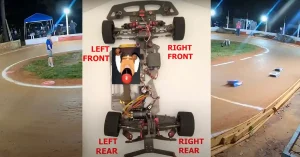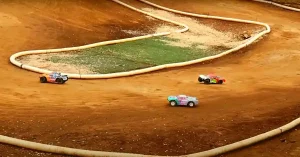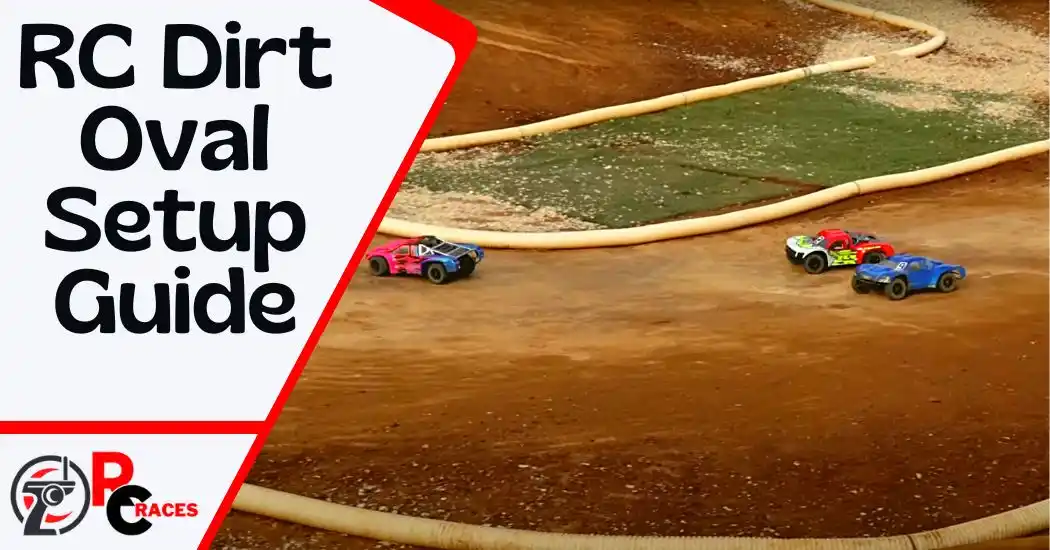Are you into competitive RC racing and thinking about getting into a dirt oval race?
Now eager to look for an RC dirt oval setup guide?
You need to follow distinct directions to set up your RC for a dirt oval. Firstly, you need to balance out your RC. Afterward you need to adjust the settings to the correct maneuvers. Other than that you need to watch the suspensions. However, most importantly you need to take care of the handling.
Now, look into details about the matter.
Basic Idea Of Dirt Oval Setup
The most critical component in creating a fast Dirt Oval car is the chassis setup. There is, however, no one-size-fits-all setup that will work for every car and track. It is because of circumstances for every driver.

One driver may like a vehicle that steers violently. While another prefers a car that is smoother and slower to react.
Balance Of The Set-Up
Balance is the most crucial thing for any driver to find! It indicates that the front and back ends of the automobile have equal traction. This provides the driver with a pleasant feeling when driving at high speeds.
If your vehicle bends into the curve beautifully and slides out, you have a “loose” race car. It also will need to add traction to the rear end to improve chassis balance.
Similarly, if your car appears to lack steering entering a turn. Also, you have to slow down excessively to get around the bend. Then you are driving a “tight” racing car.
Finding and keeping balance is the key to driving a consistently fast vehicle on any racing track. Then your objective is to find a balanced configuration rather than a fast setup.
A quick setup may provide an extremely fast track. However, a balanced setup will indeed be simpler to drive for four minutes. This frequently results in a faster total run. However, if you are looking for a faster run, your choice could be rustler or stampede.

Knowing What to Adjust
The majority of racing chassis is delivered with a “standard” or “Kit” setup. Most businesses invest hours and hours in testing and development to create their baseline arrangement.
Starting with a standard/ kit setup is my recommendation. The standard configuration is usually the setting it in its basic settings. In detail, it is believed to produce a particularly pleasant handling chassis on a variety of track surfaces. If you are looking for some great standard setups, I have some suggestions.
| Name | Details |
|---|---|
| Product 1 | |
| Product 2 |
Hope you like these recommendations.
Consider this your home. If you become “lost” in your tuning and discover that you will have managed to lose the equilibrium of your automobile. Then return “home” to the baseline configuration and begin again!
However, to adjust the motors for which you can choose a 550 motor or a 540 motor.
The purpose
The goal of this tuning is to enable you to enjoy racing dirt ovals. Also learn the numerous chassis tweaks available to you to modify your vehicle. It fits both track circumstances and your driving talents. . Please remember that there are various ways to construct a vehicle.
“There are a thousand ways to make a cake,” I like to say, “you just need to choose the recipe that you like.” Although not all chassis modifications have the same precise impact in every circumstance.
Following the information in this tutorial should help you obtain a broad grasp of the chassis setup. The majority of these chassis changes are applicable to any track surface.
The Exception
However, in extreme track conditions, a modification doesn’t always have the desired impact on handling. My objective is to assist you in better understanding which chassis modifications you should make.
What they should do, and why they do what they do. Once you understand this, you should be able to determine when to make which adjustments. In order to obtain the greatest chassis configuration feasible for the current conditions.
The Basics Of Suspension Theory: Suspension Theory 101
Your suspension has only one purpose that is to govern a lot of weight distribution to each point of the chassis. It influences what amount of traction the tire can create.
Every suspension component contributes to weight distribution management. Each chassis tuning modification alters the quantity and location of weight transfer. It is also affecting the overall balance of the automobile. The skill of managing weight transfer is known as chassis setup.
In general, a “tight automobile” is an easy car to drive, but a “loose car” is far more difficult to handle. “Hook up the rear, then make her steer,” is my particular chassis setup motto.
Easy driving benefits all races. Even the most gifted racers can go quicker in a chassis that is easy to operate.
The handling
To fully comprehend what the chassis is doing, we must first review the basic handling characteristics:
- On-Power Steering: This refers to how the automobile steers when the throttle is depressed.
- Off-Power Steering: Disabled
- Power Steering refers to how the automobile steers. It is particularly when it is in neutral or has no throttle applied.
- Push: When the car corners but the front tires slide more than the rear tires. An automobile with a “push” has insufficient steering.
A car that “tries to push” is easier to drive, but it pulls slowly than a car that really is slightly “loose.” (Also spelled “tight” or “understeer”)
4 Segments To Work On
To determine which sections of the track require attention, we must divide the track into four pieces.
- Corner Entry: The beginning phase of the bend where you start turning in. This is the point at which the front of the car descends towards the track. Afterward, the rear of the car lifts slightly, shifting load to the front tires and improving handling. (Powerless Steering)
- Mid Corner: You utilize your engine and steer to control the vehicle steadily.
- Corner Exit: This is the point in the turn when you start applying throttle. When you accelerate the front end rises and the rear end squats. This adds weight to the rear tires and enhances rear traction (Steering by Hand)
- Straights: The straight section of the track following corner departure when you are normally full throttle, and likely backing off of the throttle before to corner entering.
You can evaluate what alterations will best fit your needs if you can identify what your car is doing in each portion of the track.
Half the battle is determining what your automobile is just doing and where it is doing that. This is sometimes the most difficult item for inexperienced racers to “get a feel for.”
FAQs
Can I use a custom chassis for dirt oval RCs?
You certainly can. While there are prepared dirt oval RCs available, like Traxxas street stock, they may always be customized. Keep the chassis as light as possible.
Why use foam over rubber tires for dirt oval racing?
Tires made of foam are lightweight and get a more consistent contact patch. These provide less unsprung weight and more constant traction. There are more compounds to deal with in foam tires.
Does foam tire price vary over compounds?
Yes. There are various types of foam tires. Some are available in dual compounds. They have diverse effects and are appropriate for various tunes. As a result, their prices differ.
Conclusion
Hope you got a clear and cut idea about an RC dirt oval setup guide.
To be more precise, focus on the balance and suspensions. It will all work out for the better.
Well, good luck with your race and thank you for reading.


